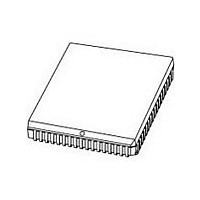P80C592FFA NXP Semiconductors, P80C592FFA Datasheet - Page 70

P80C592FFA
Manufacturer Part Number
P80C592FFA
Description
Manufacturer
NXP Semiconductors
Datasheet
1.P80C592FFA.pdf
(108 pages)
Specifications of P80C592FFA
Cpu Family
80C
Device Core
80C51
Device Core Size
8b
Frequency (max)
16MHz
Interface Type
CAN/UART
Program Memory Type
ROMLess
Program Memory Size
Not Required
Total Internal Ram Size
512Byte
# I/os (max)
40
Number Of Timers - General Purpose
3
Operating Supply Voltage (typ)
5V
Operating Supply Voltage (max)
5.5V
Operating Supply Voltage (min)
4.5V
On-chip Adc
8-chx10-bit
Instruction Set Architecture
CISC
Operating Temp Range
-40C to 85C
Operating Temperature Classification
Industrial
Mounting
Surface Mount
Pin Count
68
Package Type
PLCC
Lead Free Status / Rohs Status
Compliant
Available stocks
Company
Part Number
Manufacturer
Quantity
Price
Company:
Part Number:
P80C592FFA
Manufacturer:
PANASONIC
Quantity:
1 200
Part Number:
P80C592FFA
Manufacturer:
PHI
Quantity:
20 000
Company:
Part Number:
P80C592FFA/00
Manufacturer:
SYSTECH
Quantity:
40
Part Number:
P80C592FFA/00
Manufacturer:
NXP/恩智浦
Quantity:
20 000
Company:
Part Number:
P80C592FFA/00,512
Manufacturer:
ON
Quantity:
300
Company:
Part Number:
P80C592FFA/00,512
Manufacturer:
NXP Semiconductors
Quantity:
10 000
Company:
Part Number:
P80C592FFA/00,518
Manufacturer:
NXP Semiconductors
Quantity:
10 000
Company:
Part Number:
P80C592FFA/00Ј¬512
Manufacturer:
NXP
Quantity:
702
Philips Semiconductors
16 OSCILLATOR CIRCUITRY
The oscillator circuitry of the P8xC592 is a single-stage
inverting amplifier in a Pierce oscillator configuration. The
circuitry between XTAL1 and XTAL2 is basically an
inverter biased to the transfer point. Either a crystal or
ceramic resonator can be used as the feedback element to
complete the oscillator circuitry. Both are operated in
parallel resonance. XTAL1 (pin 34) is the high gain
amplifier input, and XTAL2 (pin 33) is the output
(see Fig.23). If XTAL1 is driven from an external source,
XTAL2 must be left open (see Fig.24).
17 RESET CIRCUITRY
The reset pin RST is connected to a Schmitt trigger for
noise rejection (see Fig.25). A reset is accomplished by
holding the RST pin HIGH for at least two machine cycles
(24 oscillator periods). The CPU responds by executing an
internal reset. During reset ALE and PSEN output a HIGH
level. In order to perform a correct reset, this level must not
be affected by external elements.
Also with the P8xC592, the RST line can be pulled HIGH
internally by a pull-up transistor activated by the Watchdog
timer T3. The length of the output pulse from T3 is
3 machine cycles. A pulse of such short duration is
necessary in order to recover from a processor or system
fault as fast as possible.
During Power-down a reset could be generated internally
via the CAN Wake-Up interrupt. Then the RST pin is pulled
HIGH for 6144 machine cycles. In this case the
CAN-controller is not reset.
If the Watchdog timer or the CAN Wake-Up interrupt is
used to reset external devices, the usual capacitor
arrangement for Power-on-reset (see Fig.26) should not
be used.
However, the internal reset is forced, independent of the
external level on the RST pin.
The MAIN RAM and AUXILIARY RAM are not affected.
When V
A reset leaves the internal registers as shown in Table 83.
1996 Jun 27
8-bit microcontroller with on-chip CAN
DD
is turned on, the RAM content is indeterminate.
70
handbook, halfpage
handbook, halfpage
handbook, halfpage
Fig.24 Driving P8xC592 from an external source.
RST
(not TTL compatible)
V DD
external clock
Fig.25 On-chip reset configuration.
R
on-chip
Fig.23 P8xC592 oscillator circuit.
RST
not connected
20 pF
20 pF
C2
C1
MLA888
MLA889
XTAL1
XTAL2
XTAL1
XTAL2
Product specification
overflow timer T3
wake-up reset
CAN
CPU
P8xC592
34
33
34
33
MGA170 - 1
















